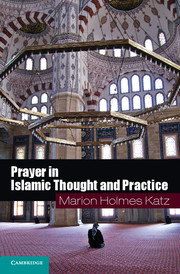3 - Interpretive models
What is ṣalāt, and what does it do?
Published online by Cambridge University Press: 05 April 2013
Summary
In general, the legal texts setting forth the components and conditions of valid prayer deal only with actions and their normative statuses (obligatory, recommended, permitted, repugnant, or forbidden). By virtue of their genre they rarely address broader issues of meaning and function. The implicit question to which they respond is “What must I do?” rather than “What kind of activity is this, what does it signify, and what does it achieve?” Of course, some of the questions raised by jurists are revealing in this regard; for instance, legal arguments addressing the actions conducive to concentration in ṣalāt imply the centrality of certain mental states to the objectives of prayer. However, such incidental forays into the interpretation of prayer do not provide an overall account of the role of ṣalāt within a religious worldview.
It is possible to interpret this omission as carrying an implicit interpretation of its own, one that posits adherence to the divine command (regardless of content) as a supreme value eclipsing – or even willfully denying – any appeal to the human meaningfulness of any given religious rite. If the rituals defined by Islamic law are pure exercises in obedience, then it is not only unnecessary but perhaps perverse to invest them with humanly defined significance or attempt to identify their underlying objectives. The idea of the intentional human incomprehensibility of acts of worship (or, indeed, of other provisions of the divine law) is expressed within the Islamic legal tradition by the expression taʿabbud, which designates a pure act of servanthood. An action may be deemed taʿabbudī on the grounds that it is incomprehensible (lā yuʿqalu maʿnāhu, ghayr maʿqūl al-maʿnā) or lacks an identifiable rationale (ʿilla). The slippage between comprehensibility and function is reflected in Islamic jurists’ usage of the word maʿnā, which may be used to refer both to “meaning” in the semantic sense and to the motivating factor (ʿilla) identifiable as a rule’s rationale. Although acts of ta’abbud are usually assumed to have some underlying purpose and meaning, these are known only to God.
- Type
- Chapter
- Information
- Prayer in Islamic Thought and Practice , pp. 75 - 127Publisher: Cambridge University PressPrint publication year: 2013



